If you want to fit three single beds in a single room, then you know it can be a challenging task, especially when space is limited. But with some clever thinking, we can totally make it work. Even if space is tight, there are lots of ways to get creative with the layout. In this post, we will explore different creative ideas for placing 3 single beds in one room, offering options for different room sizes and layouts.
Traditional placement: side-by-side configuration

The simplest solution is to place the three single beds next to each other in a traditional arrangement. Line up the beds along a wall, leaving space between each bed for easy access and movement. This layout works well in larger rooms with enough space to comfortably accommodate all three beds. Provides a symmetrical and balanced appearance, allowing each occupant to have a sleeping area.
Method:
- Align the three single beds along one wall, leaving sufficient space between each bed for easy access and movement.
- Place them in a symmetrical manner, ensuring that each occupant has their personal sleeping area.
Pros:
- Simple and straightforward arrangement.
- Provides a sense of symmetry and balance.
- Allows for easy access to each bed.
- Suitable for wider rooms with ample space.
Bunk Bed Configuration Ideas: Use of Vertical Space
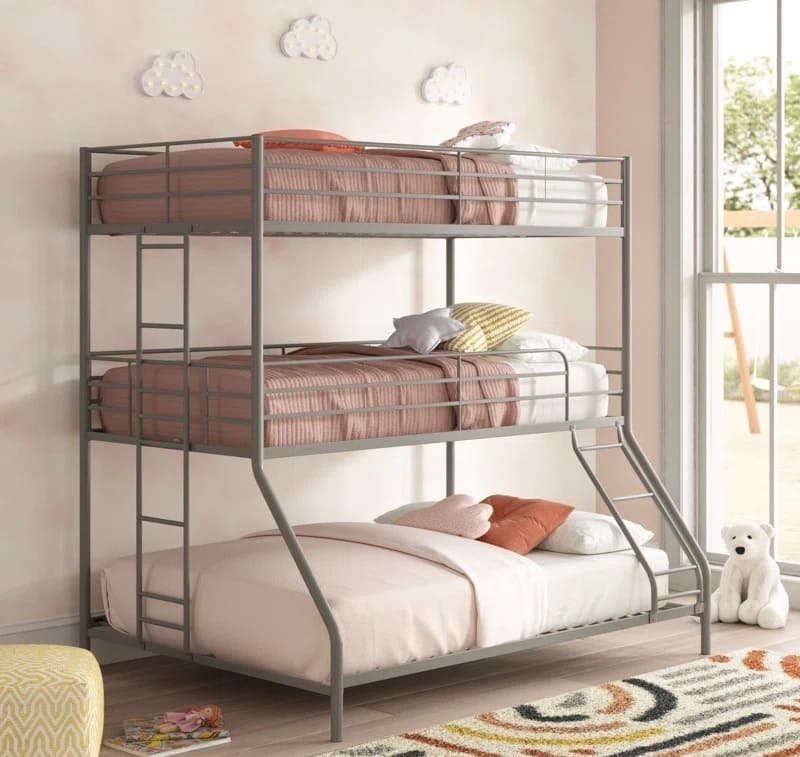
If you have limited space, consider using bunk beds for two of the beds. Place a bunk bed against a wall, with the top and bottom beds stacked vertically. This configuration saves valuable space and creates more space for other furniture or activities. Place the third single bed next to the bunk bed, forming an L-shaped layout. This arrangement maximizes vertical space and offers a practical solution for rooms with limited square footage.
Method:
- Use bunk beds for two of the beds, with one bed stacked on top of the other.
- Position the bunk beds against one wall, leaving space for easy access to the top and bottom beds.
- Place the third single bed adjacent to the bunk beds, forming an L-shape configuration.
Pros:
- Maximizes vertical space and saves floor space.
- Provides separate sleeping areas for each occupant.
- Leaves more room for other furniture or activities.
- Ideal for rooms with limited square footage.
Cons:
- The person sleeping on the top bunk may require additional safety precautions.
- Access to the top bunk may be challenging for some individuals.
- Limited headspace on the bottom bunk.
L-shaped layout: creating separate sleeping areas
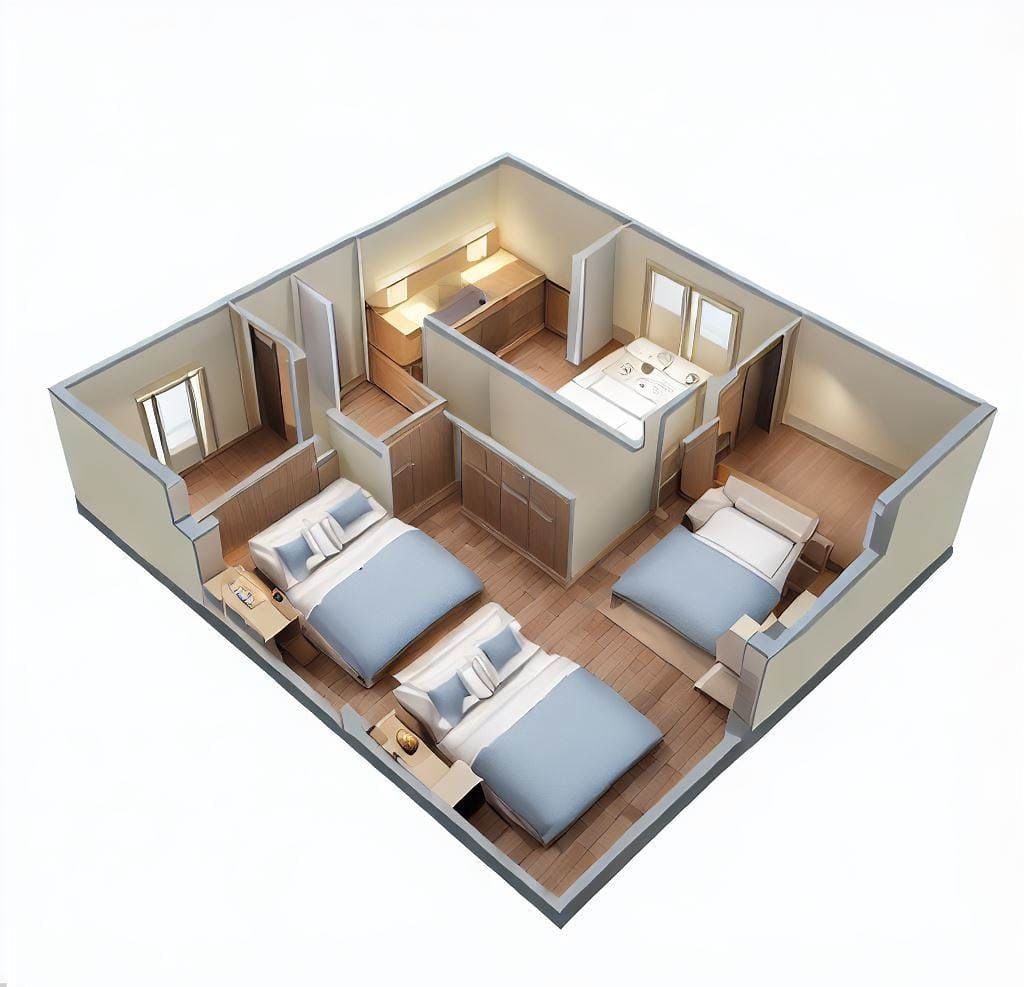
You can create an L-shaped configuration in larger rooms with three single beds. Place two sides along one wall, then place the third bed perpendicular to the other two, forming an L. This layout provides separate sleeping areas and offers a sense of privacy and individual space for each occupant. It can be beneficial if the room is shared by siblings or roommates who prefer personal space.
Method:
- Place two single beds side by side along one wall.
- Position the third single bed perpendicular to the other two beds, forming an L-shape.
- Leave sufficient space between each bed for ease of movement.
Pros:
- Offers separate sleeping zones and a sense of privacy for each occupant.
- Provides a visually appealing and well-defined arrangement.
- Works well in larger rooms, allowing for comfortable movement.
Cons:
- Requires a larger room to accommodate the L-shaped configuration.
- May limit the available floor space for other furniture or activities.
Loft bed solutions: efficient use of vertical space
Another option to save space is to incorporate High Beds into the design. Loft beds elevate one or two beds off the floor, creating space underneath that can be used for extra storage, a study area, or a cozy reading nook. By placing two loft beds side by side along one wall and placing the third single bed next to them, you can create a compact and functional sleeping area while maintaining separate spaces for each occupant.
Method:
- Incorporate loft beds into the design, elevating one or two beds above the floor.
- Position two loft beds side by side along one wall.
- Place the third single bed adjacent to the loft beds, creating a compact and functional sleeping area.
Pros:
- Maximizes vertical space and allows for additional storage or functional space underneath the loft beds.
- Provides separate sleeping areas while optimizing floor space.
- Ideal for rooms where storage or study areas are needed.
Cons:
- Climbing up and down the loft beds may be challenging for some individuals.
- Limited headspace underneath the loft beds.
Trundle bed system: maximizing flexibility
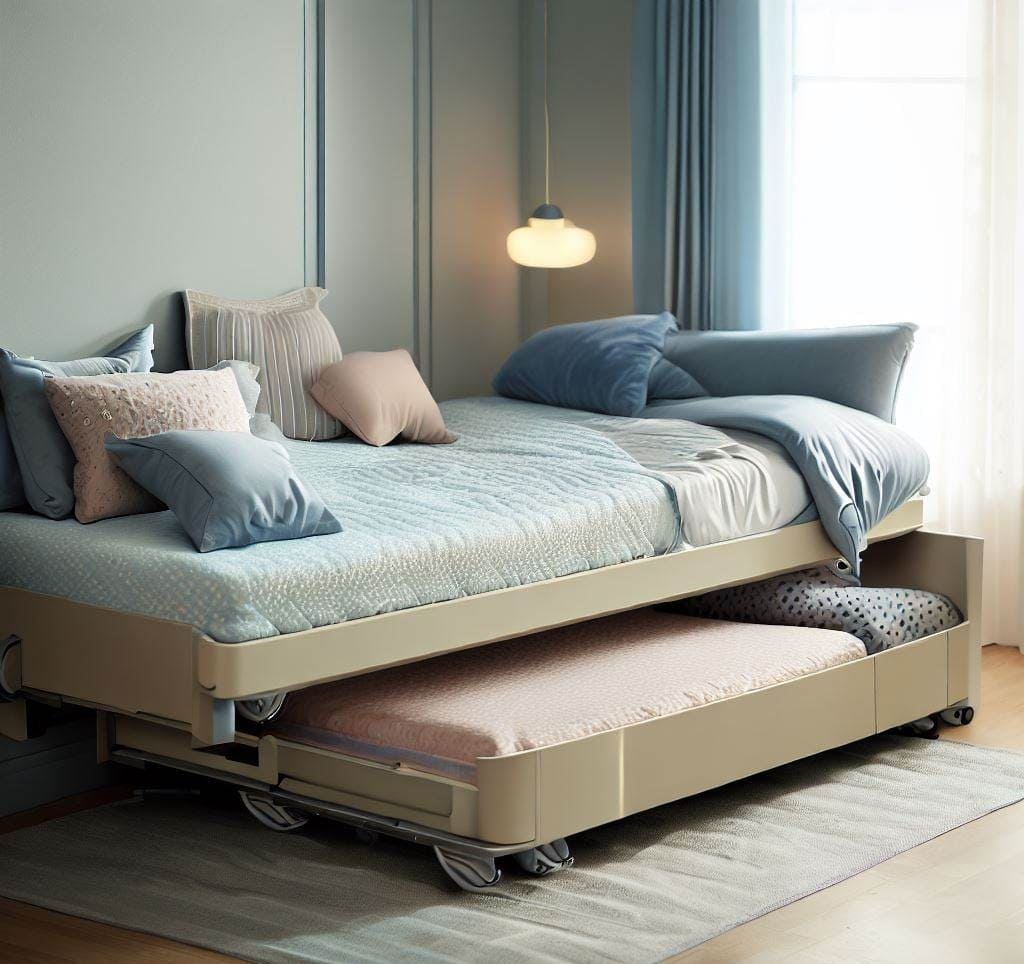
If you need additional sleeping options for occasional guests, consider incorporating a trundle bed system into your design. A trundle bed is a low-profile bed that can be stored under one of the twin beds when not in use. It can be easily removed and installed when needed, providing a convenient and space-saving solution for hosting guests.
Method:
- Choose one single bed with a trundle bed system, which can be stored underneath when not in use.
- Position the other two single beds side by side along one wall.
Pros:
- Offers additional sleeping options for guests.
- Allows for easy storage and accessibility of the trundle bed.
- Maximizes floor space when the trundle bed is not in use.
Cons:
- The trundle bed may have limited mattress thickness and comfort compared to standalone single beds.
- Requires additional effort to set up and put away the trundle bed.
Additional Tips for 3 Single Beds in One Room:
Here are some additional tips
- Opt for beds with built-in storage drawers or shelves to maximize storage space and minimize the need for additional furniture.
- Use bedding and décor that mix or match to create a cohesive and visually pleasing look.
- Consider adding a small nightstand or nightstand between each bed to provide individual storage space for personal items.
- Use wall-mounted shelves or floating shelves to store books, personal effects, or decorative items without taking up valuable floor space.
- If the room has a closet, organize it effectively to make the most of the available storage space.
Final Thoughts
Arranging 3 single beds in a room requires careful planning and creativity to optimize the use of space and ensure the comfort and privacy of each occupant. Whether you choose a traditional side-by-side layout, use bunk beds, create an L-shaped configuration, add loft beds, or implement a trundle bed system, the key is to maximize functionality and create a harmonious sleeping environment. Consider the size and layout of your room, the specific needs of the occupants, and the storage options available to design an attractive, space-efficient bedroom that meets the requirements of everyone involved. With these creative ideas, you can create a comfortable, well-organized room that encourages restful sleep and makes the most of the available space.
FAQs:
Q1: What are the key considerations when arranging three single beds in one room?
- The size and layout of the room
- The number of occupants and their individual needs
- The available floor space and storage options
Q2: How do I create separate sleeping areas with three single beds?
- Consider using bunk beds or loft beds to maximize vertical space.
- Position the beds in an L-shape or side-by-side configuration to create separate zones.
- Utilize furniture or room dividers to create a visual separation between the beds.
Q3: What are the benefits of using bunk beds or loft beds for three single beds?
- Bunk beds or loft beds save floor space, making them ideal for smaller rooms.
- They provide separate sleeping areas while maximizing vertical space for additional storage or activities.
Q4: Can I incorporate storage solutions with three single beds in one room?
- Yes, consider beds with built-in drawers or shelves to maximize storage space.
- Utilize under-bed storage containers or utilize vertical wall space with shelves or hanging organizers.
Q5: How can I ensure privacy in a shared bedroom with three single beds?
- Position the beds in an L-shape or utilize room dividers to create individual sleeping zones.
- Use curtains or privacy screens to provide a visual separation between each bed.
Q6: Are there any safety considerations with bunk beds or loft beds?
- Ensure that bunk beds comply with safety standards and have sturdy guardrails for the top bunk.
- Use proper ladder or staircase access for the top bunk to prevent accidents.
Q7: Can I incorporate additional furniture or activities in a room with three single beds?
- Consider using space-saving furniture like foldable desks or chairs.
- Utilize wall-mounted shelves or storage units to maximize floor space for activities or other furniture.
Q8: How can I make the room aesthetically pleasing with three single beds?
- Use coordinated bedding and decor to create a cohesive look.
- Incorporate elements like wall art or rugs to add visual interest and personalization.
Q9: Can I use different-sized single beds in the same room arrangement?
- It is best to use beds of the same size to maintain symmetry and balance in the room.
- However, if space constraints require different-sized beds, ensure that the arrangement remains visually pleasing and functional.
Q10: How can I optimize comfort and functionality in a room with three single beds?
- Choose mattresses and bedding that prioritize comfort and support.
- Consider incorporating bedside tables or storage units for each bed to provide convenience and personal space.
You May Also Read
Check How to Arrange 2 Dressers in a Bedroom


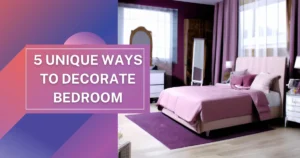
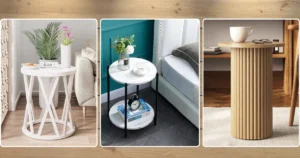
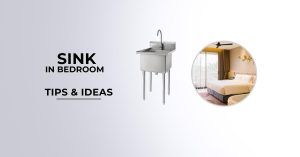
Pingback: How to Setup Two Dressers in a Bedroom - bedroomtools.com